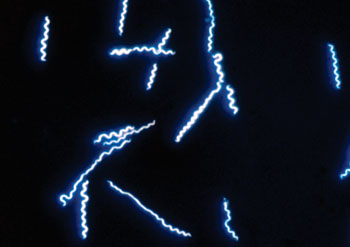New Test Developed For Early Detection Of Lyme Disease
By LabMedica International staff writers
Posted on 12 May 2016
A new test for early detection of Lyme disease (borreliosis) is being developed and this will improve the ability to detect an active infection more easily than before so that healthy people with Lyme disease antibodies in their blood do not receive unnecessary antibiotic treatment and so that appropriate treatments can be initiated at an early stage.Posted on 12 May 2016
The current test is only able to analyze part of the human immune system, namely the B-cells but not the T-cells, which are needed as helper cells to fight the infection and whose activity indicates the presence of an infection. The antibody tests that are currently available only provide a reliable result three to four weeks after infection has occurred.

Image: A dark field photomicrography reveals the presence of spirochete, or “corkscrew-shaped” bacteria known as Borrelia spp., which is the pathogen responsible for causing Lyme disease (Photo courtesy of Jeffrey Nelson).
Immunologists at the Medical University of Vienna (Austria) are developing the world's first point-of-care test, which could be used to detect an active infection so that patients could start the appropriate treatment. The test, which is known as the "Ixodes Kit" should be in clinical use in the autumn of 2016, said the scientists, speaking on the occasion of World Immunology Day 2016. Ixodes is the scientific name for hard-bodied ticks that transmit the disease.
Lyme disease is particularly common in Central Europe and in the Scandinavian countries. As a result of climate change, its area of spread is continuously moving northwards. Tick activity is starting earlier and earlier. In Austria itself, they currently have the best climate for ticks. Every year around 70,000 people in Austria develop Lyme disease after being bitten by a deer tick. Approximately one in every four ticks carries Lyme disease. So-called erythema migrans is a sure sign of infection with tick-borne Lyme disease. However, this only occurs in around one third of patients. If the bacterial infection is not detected in good time it can lead to serious problems such as joint inflammation and even very painful infections of the nerve roots resulting in paralysis or memory loss.
Hannes Stockinger, PhD, a professor and Head of the Institute for Hygiene and Applied Immunology, said, “Unfortunately, the current standard laboratory test is often unable to detect Lyme disease at an early stage of the infection. On top of that, the current test often interprets a mere antibody reaction as an infection and people are treated with antibiotics unnecessarily, because the infection is way in the past or is already completely resolved.” In Europe and Asia, the bacteria Borrelia afzelii and Borrelia garinii are the causes of Lyme disease.
Related Links:
Medical University of Vienna













